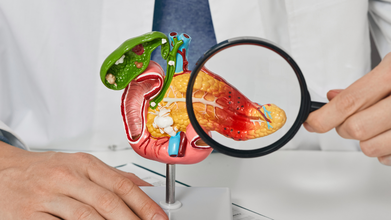- Health Conditions A-Z
- Health & Wellness
- Nutrition
- Fitness
- Health News
- Ayurveda
- Videos
- Medicine A-Z
- Parenting
Why Is This Doctor Asking President Trump To Take Alzheimer's Test?

Credits: AP and Neuropsychologysources
After two psychologists raised questions about the US President Donald Trump's mental health, saying that he showed signs of frontotemporal dementia (FTD), questions about his cognitive health is again intensified after Dr Narinder Kapur, a consultant neuropsychologist and visiting professor at the University College London said that president's behavior over the last six months has been "quite odd and strange," as reported by Express, UK.
Kapur said that Trump's suggestion that Canada should become the 51st US state. and his desire to "take over Greenland", and his controversial comments linking autism with paracetamol are really "bizarre". “Even though he’s probably been led a bit by [Robert F.] Kennedy [Jr.] on that, still for Trump to say the things he did was really quite odd and bizarre,” he said.
Also Read: Listeria Outbreak That Recalled Frozen Foods From Walmart Leaves 4 Dead, And 19 In Hospital
While Kapur did not diagnose Trump with dementia, he did suggest the possibility of frontotemporal dementia. “If one was thinking about the various possible dementias he’s got, certainly frontotemporal dementia is one of them, because some of his behavior has been really quite bizarre,” he said, adding that an Alzheimer’s test would help clarify concerns.
Is Trump Really Mentally Fit?
Trump, 79, has dismissed doubt about his mental fitness and calling himself the "stable genius". However, a report by the Guardian highlights growing number of unusual public appearances of Trump, which may suggest otherwise.
On his July trip to the UK, Trump unexpectedly veered into a monologue about windmills while meeting European Commission president Ursula von der Leyen. For two minutes, he claimed without evidence that wind turbines were driving whales “loco” and destroying scenery. “The abrupt changes in conversation are an example of Trump digressing without thinking, he’ll just switch topics without self-regulation,” Harry Segal, senior lecturer in psychology at Cornell University, told The Guardian.
Another instance is from a cabinet meeting intended to discuss global crises, Trump instead spoke for over 13 minutes about lamps, frames, and the color of paint used in the cabinet room.
What Are The Experts Saying?
Experts have pointed out that Trump's apparent tendency toward confabulation, which refers to confidently recounting events that never happened. The Guardian reported that Trump recently claimed his late uncle professor John Trump had taught Ted Kaczynski, the Unabomber, at MIT. The timeline makes this impossible: John Trump died in 1985, more than a decade before Kaczynski was publicly identified, and Kaczynski never studied at MIT.
Also Read: Newest Covid Variants Nimbus And Stratus Are On The Rise, Here's What We Know About It
Richard A. Friedman, professor of clinical psychiatry at Weill Cornell Medicine, told The Atlantic after one such performance: “If a patient presented to me with the verbal incoherence, tangential thinking, and repetitive speech that Trump now regularly demonstrates, I would almost certainly refer them for a rigorous neuropsychiatric evaluation to rule out a cognitive illness.”
Psychologist Dr. John Gartner, formerly of Johns Hopkins University, has tracked what he describes as a “major deterioration” in Trump’s language skills, motor skills, and impulse control. “If you go back and look at film from the 1980s, [Trump] actually was extremely articulate… now he really has trouble completing a thought and that is a huge deterioration,” Gartner told The Guardian.
He warned that Trump’s decline may accelerate: “At the rate he is deteriorating, it’s going to get worse. That’s my prediction.”
Why GLP-1 Medications Can Trigger Hair Loss In Some People

Credits: Canva
Carol Saffran began taking Ozempic a year ago to manage her blood sugar after other treatments hadn’t worked. She was prediabetic, meaning her blood sugar was higher than normal, and her doctor prescribed Ozempic to help prevent diabetes. She has since reached near her ideal weight and has a checkup scheduled soon to monitor her blood sugar, but after increasing to the highest dose, she noticed something unexpected.
“I would brush my hair and notice more hair than usual on the brush,” said Saffran, 71, from the greater Boston area, as per CNN. “It’s not falling out in clumps, but it’s definitely thinner. My hair isn’t as full as it used to be.”
Dr. Farah Moustafa, a hair loss specialist and director of laser and cosmetic treatments at Tufts Medical Center, diagnosed her with telogen effluvium, a type of hair loss caused by stress on the body. In Saffran’s case, the stress was the significant weight loss she experienced while on Ozempic.
Carol Saffran said her hair isn’t as full as it was before taking a GLP-1 drug. Courtesy Carol Saffran
What is Telogen Effluvium?
Hair grows in four phases: anagen (growth), catagen (transition), telogen (resting), and exogen (shedding). Normally, anagen lasts the longest, as per Cleveland Clinic.
Telogen effluvium pushes an unusually high number of hair follicles into the telogen phase, causing more shedding than usual. Dr. Anthony Rossi, a dermatologist at Memorial Sloan Kettering Cancer Center, explained that telogen effluvium often appears after periods of stress such as childbirth, anesthesia, or rapid dieting.
“Any time people lose a significant amount of weight quickly, it can trigger telogen effluvium, where more hair follicles enter the shedding phase prematurely,” said Dr. Aron Nusbaum, a dermatologist and hair restoration surgeon at the Miami Hair Institute.
He added that this type of hair loss can appear three to six months after a triggering event, whether it’s physical stress, emotional stress, hormonal changes, major weight loss, or a new medication.
When the body is stressed, it prioritizes essential functions over nonessential ones, like hair growth. “Hair is a nonessential appendage,” Rossi said. Experts agree that the major cause of hair loss among GLP-1 users appears to be the significant weight loss rather than the medication itself.
Malnutrition May Play a Role
Dr. Brian Wojeck, an obesity medicine specialist at Yale School of Medicine, compared it to what happens after bariatric surgery, where rapid metabolic changes can trigger temporary hair shedding. He also suspects that sudden changes in nutrition or vitamin levels might contribute. Some people consider taking multivitamins while on GLP-1 medications, though “there isn’t strong evidence that multivitamins prevent hair loss,” he said.
Rossi noted that some patients become relatively malnourished on GLP-1s because the drugs suppress appetite. “If you aren’t getting enough micronutrients, your body won’t prioritize hair growth,” he said. “It’s a mix of metabolic stress and relative protein or nutrient deficiency.”
For healthy hair, people need about 1 gram of protein per kilogram of body weight daily, plus sufficient levels of ferritin, zinc, and vitamins B, D, and B-12, Rossi said.
Manufacturer Guidance
A Novo Nordisk spokesperson confirmed hair loss is listed as a possible side effect of semaglutide. Clinical trials of Wegovy reported hair loss in 2.5% of participants versus 1% of placebo, with higher risk for those losing 20% or more of body weight. Alopecia is noted in post-marketing materials for Ozempic and Rybelsus.
Eli Lilly confirmed hair loss has been observed with weight loss interventions. It is listed for Zepbound but not Mounjaro, which is approved for diabetes management rather than weight loss. Zepbound trials showed higher hair loss rates in women (7.1%) than men (0.5%).
Treatments for Hair Loss
Telogen effluvium from GLP-1 use is usually temporary, but medical evaluation is advised. Chronic telogen effluvium, where shedding lasts more than six months, can occur, Rossi said.
Moustafa explained that once the stressor is removed, hair should fully recover. Medications like oral minoxidil can help speed regrowth, especially for patients who must continue a medication like Ozempic. Saffran plans to lower her dose and start minoxidil while continuing treatment. Nusbaum emphasized proper diagnosis is essential. Ruling out other causes through lab tests for vitamin, mineral, and hormonal levels allows for faster recovery.
For Saffran, Moustafa confirmed she had thick hair initially, with no signs of age-related pattern loss, indicating pure telogen effluvium. She advises GLP-1 users to monitor their hair shedding, track weight loss, and advocate for referrals to specialists to manage the condition.
Early Warning Signs of 'Silent Killer' Cancer: Study Finds Symptoms That Could Help Early Diagnosis

(Credit-Canva)
Pancreatic cancer is widely known as a "silent killer" because it doesn't usually cause pain or noticeable issues until it is very advanced and hard to treat. This is why doctors and researchers are always searching for earlier signs. Fortunately, new research has uncovered a possible warning sign that could help find the disease much sooner. Detecting this cancer early, when it is small and hasn't spread, gives patients the best chance for a successful recovery.
Why Is Pancreatic Cancer Difficult To Diagnose?
The statistics for pancreatic cancer show just how deadly it is. Even though it makes up a small percentage of all cancer cases (around 3%), it is responsible for a large number of cancer deaths (about 8%).
This high death rate happens because the cancer is often only found after it has already spread to other organs in the body. When cancer is found late, the chance of survival is very low—only about 3% to 16% of people live for five years or more. Because of these low survival rates, finding a dependable way to spot this cancer early is absolutely essential to saving more lives.
Early Sign of Pancreatic Cancer
Researchers at Johns Hopkins University School of Medicine have discovered a promising sign that might point to early cancer: the pancreatic duct is enlarged. The pancreatic duct is basically a tube that carries the digestive juices out of the pancreas.
In their study, published in the journal Gastro Hep Advances, the research team found that if this duct is swollen or enlarged, it suggests a much higher risk of developing pancreatic cancer. This sign is particularly important for people who already have a high chance of getting the disease due to family history or genetics.
The researchers studied 641 people who were already considered to be at a high risk for pancreatic cancer, either because close family members (like parents or siblings) had it, or because they had specific genes that increase the danger.
Key Discovery: They found that 97 of these high-risk patients had this enlarged pancreatic duct.
Increased Odds: When they tracked these patients, they found that those with the duct enlargement were 2.6 times more likely to eventually get pancreatic cancer compared to the people without the enlargement. The danger was even greater if they had the enlarged duct and three or more fluid-filled sacs, called cysts, on their pancreas.
Will This Increase Pancreatic Cancer Survival Rate?
This discovery gives doctors a clear signal to take action. If a doctor sees an enlarged pancreatic duct on a medical scan—even if the scan was initially ordered for a different issue, like checking for kidney stones or general belly pain—they should immediately treat it as a warning sign.
Next Steps
The action taken would be to either perform very frequent and detailed imaging (scans) to watch the area closely, or in some cases, do surgery to remove the tissue concerned.
Can This Improve Chances Of Diagnosis?
Dr. Canto pointed out that sometimes, the swelling in the duct is visible even before the cancerous mass itself is big enough to be clearly seen on a scan. This means doctors have a valuable new chance to step in earlier than ever before.
The research is not stopping here; the team’s next big project is to teach Artificial Intelligence (AI) how to look at pancreas scans. The goal is for the AI to analyze the images and make even more specific and accurate predictions about a person's risk of developing pancreatic cancer.
Do We Have A Safe Amount Of Using Toothpaste? This Is What A Dentist Revealed

Credits: Canva
Most toothpaste commercials show a long, dramatic swirl covering the entire length of the toothbrush. But dentists say this is not only misleading, it could actually be harmful.
A video shared by Dr. Miles Madison, Beverly Hills Periodontist & Dental Implant Specialist, has sparked fresh debate on how much toothpaste is truly safe. Paired with expert insights and existing dental research, one message is clear: more toothpaste does not mean better cleaning.
The Big Problem: We’re Using Far More Toothpaste Than Needed
According to Dr. Madison, almost 40% of people use an excessive amount of toothpaste, as shown by CDC findings. The amount typically seen in commercials? “That much is a hell no,” he says.
His guidance on the correct amount is straightforward:
For Babies and Toddlers (Teeth Eruption to Age 3)
Use only a smear, roughly the size of a grain of rice.
This tiny amount protects the teeth without overexposing children to fluoride, especially since young kids often swallow toothpaste instead of spitting it out.
For Ages 3 and Above
Use a pea-sized amount no more.
This is enough to clean the teeth thoroughly without increasing health risks.
Why Using Too Much Toothpaste Is Harmful
Children under eight have teeth and gums that are still developing. Overusing toothpaste, particularly fluoride-containing toothpaste, can trigger dental fluorosis, a condition caused by excess fluoride intake. This results in yellow or white spots, enamel damage, pits, and an increased risk of cavities.
Because children tend to swallow toothpaste, larger amounts can quickly push them into unsafe fluoride levels.
Adults Aren’t Exempt From Risks Either
Even though adults are less likely to swallow toothpaste, using too much can still:
- Erode protective enamel over time
- Irritate gums
- Trigger sensitivity
- Leave residue that traps bacteria
- Encourage people to brush too aggressively
Dentists also warn that people often rely too heavily on toothpaste while neglecting brushing technique — gentle circular motions, not force, and flossing.
So What Does Toothpaste Actually Do?
Toothpaste works by:
- Breaking down plaque
- Fighting bacteria
- Strengthening enamel
- Reducing inflammation
- Neutralizing acids
- Freshening breath
However, its benefits peak at a pea-size amount. Beyond that, the risks outweigh the rewards.
The Safe Brushing Routine Dentists Recommend
- Use only the recommended amount for your age
- Choose a fluoride toothpaste unless advised otherwise
- Use a soft-bristled brush
- Brush for two minutes
- Spit out the foam; don’t rinse immediately for long-lasting fluoride protection
- Floss daily
- Supervise young children while brushing
Used correctly, toothpaste prevents cavities, gum disease, and tooth loss, but used excessively, it can do more harm than good.
© 2024 Bennett, Coleman & Company Limited

